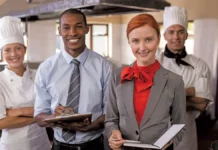
As numerous restaurants were systematically forced to close over the last 10 months, Citrin Cooperman immediately realized our role in helping our clients through such an unprecedented crisis. We understood more than ever what we needed to do to support our clients.
We hit the ground running – advising the restaurant community, providing targeted consulting services, and distributing timely regulatory information and other news affecting the industry. We also assembled a team of dedicated industry resources, with specialized knowledge of PPP and pandemic-related regulation, to address the specific needs of our clients.
Being able to accomplish that in 2021 is consistent with our mission, and the vision that Niles Citrin and Joel Cooperman had when they launched this practice over 40 years ago. From the beginning, their goal was to help clients steadily build their businesses, with smart solutions and strategies to achieve their long-term goals. While the pandemic has proven that the future is unpredictable, it also demonstrates the importance of staying focused on the potential success of your long-term goals.
Before I began at Citrin Cooperman in 2010, I was an audit and tax partner at a boutique firm, having worked in the restaurant and hospitality industry for over 25 years. Throughout my career, I’ve stuck to my personal goal of enhancing the business and personal lives of our clients. From a goal standpoint, even with COVID, nothing has changed for the restaurant/hospitality operator.
There will be endless opportunities, as real estate that was never available before comes onto the market at what should be affordable pricing. With that, will come the requisite due diligence, optimal tax structuring, budgeting and forecasting, and potentially complex state, local, or international tax issues, to set the right goals.
What has become even more clear is that, more than ever, the restaurateur needs an accounting advisor that understands the nuances of what is a very complex industry.
We saw this last Spring, as our restaurant clients struggled to understand the nuances of the PPP (Paycheck Protection Program), EIDL (Economic Industry Disaster Loan), and ERTC (Employer Retention Tax Credit). We were also able to bring added value by helping our clients understand other local grants and uncover loan programs through our resources, so they can make informed decisions about what to do next.
As we quickly discovered, there are numerous factors contributing to how those grants and programs tie into a restaurant’s cash-flow forecasting. For instance, did it/does it make sense for a restaurant to take advantage of the funding to pay an employee who they had to furlough because restaurants were closed? Our role is to educate the operator with their best options moving forward.
The spring of 2020 meant chaos and confusion concerning government funds for businesses. Restaurants needed these forgivable grants to pay their employees to keep them on the payroll, but many restaurants had to remain closed due to COVID safety concerns and guidelines. When the covered period for PPP loans was extended, it was easier for our clients to spend the money in a revenue-producing manner.
We’ve taken that expertise and we are now assisting clients as the door opens for Round #2 of PPP. The first step is to understand the changes in the program. In order to apply for the second draw of PPP, restaurants must have 300 or fewer employees, have already used their first PPP loan on the qualified costs, and have experienced a revenue reduction of 25% or more in at least one quarter of 2020 when compared to the same quarter in 2019.
Additionally, there is a cap of 2 million with a 4 million cap if the business is considered part of a single corporate group. We continue to suggest that restaurants take advantage of the funds, as most have revenue reduction and used their first loans.
There is also the ERTC that can be a benefit to restaurants that were fully or partially suspended by a governmental order for COVID 19, or had a significant decline in gross receipts. The rules for 2020 ERTC are different from 2021 ERTC.
For 2020, significant decline in gross receipts is defined where gross receipts must be less than 50% of what they were for the same quarter in 2019. Once this happens, every quarter is an “eligible quarter” until the end of a quarter where receipts are 80% when compared to 2019. Once an employer is eligible, the credits are equal to 50% of qualified wages and health care costs paid to an employee, capped at $10,000 of qualified wages per employee ($5,000 credit per employee).
Qualified wages is defined differently for employers that have more than 100 full-time-equivalent employees (FTEs), versus employers that have 100 or less FTEs. If an employer has more than 100 FTEs, only wages paid to an employee during an eligible quarter to NOT PROVIDE SERVICES are eligible for the credit. For employers that have 100 FTEs or less, all wages paid to an employee during an eligible quarter qualify for the credit.
For 2021, changes to the program include;
- significant decline in gross receipts is defined where gross receipts must be less than 80% of what they were in the same quarter in 2019,
- the credits are equal to 70% of qualified wages and healthcare costs paid to an employee, capped at $10,000 of qualified wages per employee per quarter ($7,000 credit per employee per quarter), and
- the definition of qualified wages changes when an employer has more than 500 FTEs, meaning all wages and healthcare costs paid by employers with 500 or less FTEs can qualify for the credit.
Essentially the ERTC could provide a total credit of $14,000 per employee in 2021. One thing to keep in mind is that PPP recipients are now eligible for ERTC, however no credit is allowed for the same wages used for forgiveness on the PPP loan. Although this credit was available in 2020 it was significantly limited, and few took advantage of it.
With PPP recipients now becoming eligible, businesses should revisit the other eligibility requirements for 2020 to see if they can claim credits retroactively. For 2021 ERTC, businesses can reduce its federal employment tax deposit by the anticipated credit, and/or a business can receive a refund when they have filed their quarterly payroll tax returns.
There is some strategy tied into the timing of the PPP and the ERTC so I am telling my clients to consider the funding as a strategic game. Delaying the PPP could be more economically rewarding but– do they need the money today, or can they afford to wait with the risk that there will not be funds still available for them later on?
With the back and forth on indoor dining, we also are helping our clients understand how funds can be used beyond payroll. We are approaching a new normal, which will involve a vaccinated public and what has been described as a herd immunity. With that, more people are going to become comfortable dining out. I think that what used to be a decision made based on a review on Zagat and then Yelp, will also factor in restaurants they consider to be safer.
Structures for outdoor dining and air filtration systems can be eligible costs for PPP loan forgiveness, which seems essential for the foreseeable future. As part of our advisory approach, we can help hospitality business owners analyze those opportunities and the ROI that comes with them.
We want the restaurant community to know that we are here to help you prepare for the return of your dining patrons as well as all of your other needs.

























